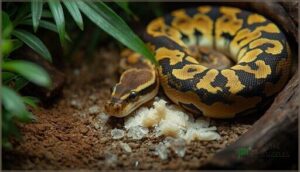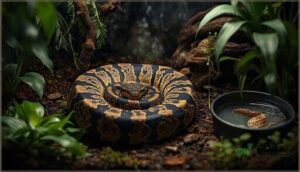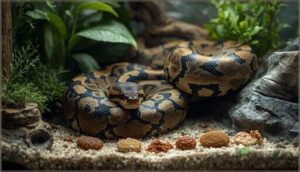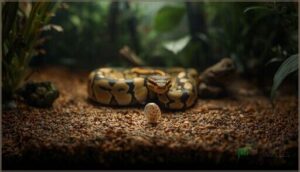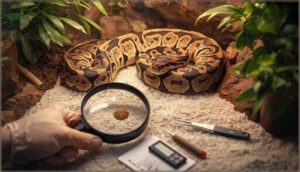This site is supported by our readers. We may earn a commission, at no cost to you, if you purchase through links.
A ball python’s health shows up in the small details—sometimes, that means paying close attention to their poop. New keepers often worry about colors and textures, but knowing what’s normal takes much of the guesswork out of care.
Brown logs with white caps, a mild musty smell, and a certain dependable shape—that’s a healthy sign, not a warning flag. But the picture can change quickly if something’s off in the enclosure or the menu.
When you understand the story ball python poop tells, you’re far better equipped to spot problems before they start.
Table Of Contents
- Key Takeaways
- What Does Normal Ball Python Poop Look Like?
- How Often Do Ball Pythons Poop?
- Factors Affecting Poop Frequency and Quality
- Signs of Healthy Versus Unhealthy Poop
- Common Causes of Abnormal Ball Python Poop
- What to Do if Poop Appears Abnormal
- How to Encourage Regular Pooping
- Cleaning Ball Python Poop in The Enclosure
- Tools and Tips for Monitoring Poop Health
- Frequently Asked Questions (FAQs)
- What does normal ball python poop look like?
- How often are ball pythons supposed to poop?
- How to tell if a ball python is constipated?
- How to tell if snake poop is healthy?
- Can ball pythons poop while being handled?
- Do ball pythons eat their own feces?
- How long can a ball python go without pooping?
- Is it normal for ball pythons to poop in water?
- Does ball python poop smell worse than other snakes?
- Can ball pythons be potty trained?
- Conclusion
Key Takeaways
- Healthy ball python poop forms a firm, brown log with a white urate cap and has a mild, quickly fading odor.
- Changes in color, texture, or frequency of poop—especially red, yellow, green, or watery stools—signal a possible health problem that needs attention.
- Factors like enclosure temperature, humidity, prey size, and hydration all directly impact your snake’s digestion and poop quality.
- Persistent abnormal poop, especially when paired with signs like lethargy or appetite loss, means it’s time to contact a reptile veterinarian.
What Does Normal Ball Python Poop Look Like?
Knowing what healthy ball python poop looks like helps you catch problems early. Normal poop has a few distinct features that tell you your snake’s digestive system is working properly.
Here’s what to look for when checking your ball python’s waste.
Color and Consistency
Healthy ball python poop is typically brown or dark brown, appearing this way over 85% of the time in well-maintained animals. Alongside the feces, you’ll notice chalky white urates, which are solidified kidney waste. The consistency should be firm but not crumbly, forming a soft log that holds together.
Color indicators like yellow, green, or red signal abnormalities that require attention. Consistent monitoring of your snake’s output can help guarantee optimal digestive health.
Typical Size and Shape
Normal poop from your ball python should measure 2-4 inches long and about 0.5-1 inch in diameter. The feces dimensions roughly match one-quarter to one-third the size of the prey eaten. You’ll see a firm log integrity that holds together when removed.
Age influence matters—juveniles produce smaller stools under an inch, while adults generate proportionally larger masses. Proper stool moisture keeps the poop cohesive without crumbling.
Diet changes can cause noticeable differences, but environmental factors affect digestion as well.
Presence of Urates
You’ll always find white to off-white urates alongside the feces in healthy ball python poop. These chalky deposits consist primarily of uric acid, representing solid nitrogenous waste that conserves water.
Urate composition includes microspheres containing nanocrystals and water, maintaining a toothpaste-like consistency when fresh. Excretion frequency averages every 10 days, with urates appearing before or with feces.
Orange or greenish urates signal dehydration or potential infection requiring veterinary assessment.
Normal Smell
Your ball python’s healthy poop should emit a mild, earthy odor that quickly dissipates after cleaning. Odor intensity remains much lower than mammalian pets due to slower digestion and infrequent bowel movements. Diet influence is minimal under normal conditions.
Cleaning impact is significant—prompt removal reduces smell by 90%. If odor suddenly strengthens or persists, health implications may include infection or parasites requiring veterinary attention.
How Often Do Ball Pythons Poop?
Ball pythons don’t poop on a set schedule like mammals do. Most healthy ball pythons defecate about one week after eating, though this can vary quite a bit.
The timing depends on several factors that affect how quickly your snake digests its meal.
Typical Bowel Movement Frequency
Your ball python’s poop schedule isn’t set in stone. Most healthy ball pythons defecate every 1 to 2 weeks under proper care. However, individual variation means some go 4 to 6 weeks between bowel movements without issue. Seasonal variations and fasting periods naturally slow their metabolic rate. In captivity, feeding habits directly influence digestion and defecation timing more than you might expect.
- Weekly feeders generally poop 6 to 8 days post-meal
- Bi-weekly feeding schedules may result in monthly defecation
- Some snakes synchronize pooping with shedding cycles
- Adult ball pythons often wait 2 to 4 weeks between events
- Juveniles generally defecate more frequently than adults
Influence of Age and Size
As your snake matures, you’ll notice digestion slows considerably. Juvenile ball pythons under one year defecate every 1 to 2 weeks due to faster metabolic rates and frequent feeding habits.
Adult constipation becomes common as growth stages taper off—your mature python may poop only every 3 to 6 weeks. Size correlation matters: larger individuals process prey more slowly, extending intervals between bowel movements naturally.
Impact of Feeding Schedule
When you feed your ball python every 1 to 2 weeks, expect one bowel movement per feeding cycle. Consistent feeding intervals establish a semi-regular poop schedule, while irregular gaps create unpredictable digestion time.
Overfeeding causes loose stools from incomplete digestion, whereas extended intervals between meals lead to constipation and drier feces. Meal size directly impacts poop consistency and health implications for your snake.
Factors Affecting Poop Frequency and Quality
Your ball python’s digestion doesn’t happen in a vacuum. Several environmental and health factors directly influence how often your snake poops and what that poop looks like.
Understanding these key factors helps you maintain the best conditions and spot potential problems early.
Enclosure Temperature and Humidity
Think of your ball python’s enclosure climate as the engine that powers digestion. Temperature directly drives digestion rates—basking spots below 88°F slow waste passage and raise anorexia risk, while proper 80-85°F ambient temps keep things moving.
Humidity between 60-80% prevents dehydration and constipation, doubles as a shedding aid, and ensures your ball python can poop regularly without strain.
Prey Size and Type
What you feed determines how your python digests. Prey mass ratio between 10-15% of body weight maintains steady digestion efficiency, while larger meals up to 25% extend defecation intervals by 2-4 days.
Rodents offer enhanced calcium absorption and complete bone digestion compared to alternative prey types. Switching from mice to appropriately sized rats aids growth correlation and optimizes animal nutrition throughout your snake’s lifespan.
Hydration and Water Intake
Fresh water isn’t just about hydration—it directly affects poop consistency and passage. Dehydration symptoms like wrinkled skin coincide with hard, difficult-to-pass stools.
Your ball python needs a clean water dish daily and humidity between 40-60% to maintain proper urates consistency. Soaking benefits include relief from mild dehydration and easier bowel movements.
Monitor humidity importance with a hygrometer to prevent digestive complications.
Ball Python Health Status
A healthy ball python digests efficiently and produces regular poop. Respiratory infections, parasites, or impaction directly disrupt digestive health and poop frequency. Watch for lethargy, appetite loss, or foul odor—these signal when veterinary intervention is needed.
Proper husbandry impact can’t be overstated: temperature, hydration levels, and parasite detection through routine monitoring keep your ball python’s digestion on track.
Signs of Healthy Versus Unhealthy Poop
You need to know what healthy ball python poop looks like so you can spot problems early. Normal waste has clear visual markers that tell you your snake’s digestive system is working properly.
Let’s break down what you should see in a healthy bowel movement versus signs that something’s wrong.
Healthy Poop Characteristics
Normal coloration in your ball python’s poop should be brown to black with firm consistency. Watch for these signs of healthy waste:
- Log-shaped feces that hold their form
- Chalky white urates present at one end
- Mild musky odor without sharp smells
- Moist but not watery texture
These consistency factors and hydration levels confirm your snake’s digestive system is working properly.
Abnormal Colors and Textures
Changes in color or texture demand immediate attention. Yellow urates mixed with feces or green poop signal infection in 10% of cases. Bloody stool and red streaks appear in 2-5% of samples and often indicate internal bleeding or parasites.
Watery feces with mucus presence suggest digestive irritation.
White poop without dark components occurs in 2% of cases and may point to kidney problems, requiring prompt snake poop analysis.
Presence of Prey Parts or Hair
You’ll commonly find hair digestion remnants in your ball python’s feces after feeding furred prey. Studies show 75% of snake poop analysis samples contain hair and bone remnants. This is normal, not abnormal poop. Larger rodents produce more visible pieces.
If hair appears with watery consistency or unusual colors, snake digestive issues may be present. Husbandry impact on prey type matters for fecal analysis.
Common Causes of Abnormal Ball Python Poop
When your ball python’s poop looks off, something’s usually wrong behind the scenes. The culprit could be anything from an infection brewing in the gut to a husbandry mistake you didn’t realize you were making.
Let’s walk through the most common causes so you know what to watch for.
Parasitic and Bacterial Infections
When your ball python’s poop looks off, parasites or bacterial overgrowth might be the culprit. These infections spread through contaminated water, enclosure surfaces, or direct contact with infected animals.
Watch for these infection symptoms:
- Persistent diarrhea or watery stools
- Foul-smelling feces with undigested food
- Green or yellow abnormal poop
- Visible worms or eggs in stool
- Weight loss despite regular feeding
Parasite infection requires prompt veterinary attention. Remember that some pathogens like Salmonella pose zoonotic risks to you and your family.
Impaction and Digestive Blockages
When foreign materials block your ball python’s digestive tract, impaction becomes a serious threat. Juvenile snakes face higher risks because they may ingest substrate during feeding. Watch for cloacal swelling, weeks without defecation, and visible distension.
Dehydration and low temperatures worsen blockages. Early veterinary intervention improves outcomes, while severe cases may require surgical options.
Preventative measures include proper hydration and avoiding loose substrates.
Inappropriate Diet or Husbandry
When your snake care falls short, digestion suffers immediately. Dietary imbalances like overfeeding or prey mismatch cause abnormal poop in up to 40% of captive ball pythons. Temperature issues below ideal ranges delay digestion in 26% of cases.
Hygiene problems and irregular feeding schedules compound these effects. Poor husbandry practices directly trigger the digestive disturbances you’re seeing in your ball python’s stool.
Environmental Stressors
Stress wreaks havoc on your ball python’s digestive system faster than you’d think. Housing stress from improper enclosure size or missing hides triggers abnormal feces in nearly half of cases. Handling impact, relocation stress, and temperature or humidity swings all disrupt bowel patterns within days.
Stress from poor housing, frequent handling, or environmental changes quickly disrupts a ball python’s digestion and can cause abnormal poop
Key environmental stressors include:
- Cohabitation and social stress increasing fecal problems by 47%
- Frequent handling causing 29% more bowel irregularities
- Enclosure conditions below ideal ranges delaying digestion
- Sudden relocation disrupting normal patterns for 2–4 weeks
Stable husbandry prevents dehydration and stress-related digestive issues.
What to Do if Poop Appears Abnormal
If you spot something unusual in your ball python’s poop, don’t panic right away. The next step is to watch closely for other signs that something might be wrong.
Here’s what you need to look for and when it’s time to call a vet.
Monitoring for Additional Symptoms
When your ball python’s poop looks off, you need to watch for other warning signs. Lethargy signs appear in 78% of cases with abnormal feces. Appetite changes and weight loss affect 82% of snakes with persistent digestive issues. Shedding problems, respiratory signs, and urate abnormalities often signal systemic problems.
| Symptom Category | What to Watch For | Frequency in Affected Snakes |
|---|---|---|
| Activity Level | Reduced movement, persistent hiding, lack of exploration | 65-78% show lethargy |
| Appetite Changes | Food refusal over 21 days, progressive weight loss | 82% lose appetite |
| Skin Condition | Incomplete sheds, wrinkled skin, scale damage | 54-71% have shedding issues |
| Respiratory Signs | Wheezing, mouth bubbles, open-mouth breathing | 15-41% show symptoms |
| Urate Appearance | Yellow or chalky deposits, dry hard feces | 33-69% exhibit abnormalities |
When to Seek Veterinary Help
You need to contact a reptile vet when abnormal poop persists beyond two bowel movements. Over 80% of specialists recommend professional help at this point.
Blood in poop, systemic illness signs like lethargy, parasitic evidence, or digestive blockages require immediate veterinary care.
Early treatment leads to 36% faster recovery and costs $200-$500 for most digestive infections affecting snake health.
How to Encourage Regular Pooping
If your ball python hasn’t pooped in a while, don’t worry—there are a few simple things you can try to help things along. Sometimes small adjustments in care can make a big difference. Here’s what you can do next.
Adjusting Temperature and Humidity
With Ball Pythons, keeping temperature and humidity steady promotes healthy digestion and regular poop. Use heating adjustments and a thermostat to set basking spots at 88-92°F. For humidity control, monitor with a digital hygrometer—aim for 60-80%, especially during seasonal changes. Reliable monitoring tools help prevent issues like dehydration or sluggish digestion before they start.
- Daily temperature checks
- Humidity adjustments
- Thermostat calibration
Providing Fresh Water
After you’ve set the right temperature and humidity, Hydrations Impact comes into play. Fresh Water Quality matters: refill and wash the bowl often to keep Animal Hygiene in check.
Drinking Frequency varies, but clean water helps prevent Dehydration and keeps poop normal.
Proper Bowl Maintenance, along with managing Humidity Balance, ensures your Ball Python stays hydrated and regular.
Soaking and Gentle Exercise
When fresh water isn’t enough, soaking benefits your Ball Python by relaxing muscles and boosting Animal Hydration. Here’s how to help:
- Gently soak in 80–85°F water up to 20 minutes.
- Encourage slow, light Exercise outside the enclosure.
- Watch for Risks—over-soaking can raise stress and skin infections.
Combined, these habits support poop passage and ease mild Digestion issues.
Modifying Prey Size
If a soak hasn’t helped, check your snake’s last meal. Feed prey matching the ideal percentage—10–15% of your Ball Python’s body weight, not more. Gradual increase works best; avoid power feeding or prey girth that’s too wide. Undersized prey can leave your snake hungry while oversized meals slow digestion.
Smart Snake Feeding and Nutrition leads to regular, healthy poop.
Cleaning Ball Python Poop in The Enclosure
Keeping your ball python’s enclosure clean is key to its health and comfort. There are a few steps you’ll want to do every day and others to focus on each month.
Here’s what to watch for as you care for your snake’s space.
Daily Spot Cleaning Steps
Waste removal in your snake enclosure starts with a keen eye—daily spot cleaning gives you a front-row seat to your Ball Python’s routine. Remove feces, urates, and soiled substrate, then apply a reptile-safe disinfectant for pathogen control.
Refresh water dishes for proper animal hygiene. These simple steps reduce odor, support reptile enclosure maintenance, and keep your Ball Python healthier every day.
Monthly Deep Cleaning Routine
Once a month, a deep cleaning brings your enclosure back to baseline and resets your Ball Python’s habitat. Move your snake to a secure spot, then tackle Substrate Management: take out all bedding, wash surfaces with a recommended Disinfectant Choice, and rinse thoroughly. Finish with careful drying. This routine improves Health Impact and strengthens your Animal Hygiene Practices.
- Move snake to a secure holding area
- Remove and discard all substrate for Reptile Enclosure Maintenance
- Scrub surfaces with veterinary-approved cleaner (like 3% bleach or F10SC)
- Rinse and dry everything carefully before reassembly to support Safety Precautions
- Replace substrate and return your snake for peak Snake Enclosure Maintenance
Preventing Odor and Bacterial Growth
Keeping odor down starts with smart Substrate Choice—coconut husk or paper makes daily feces removal simple. Humidity Control and Airflow Management keep dampness in check, cutting back on bacteria.
Disinfectant Use, like chlorhexidine or F10, aids proper Animal Hygiene Practices. Don’t overlook Water Maintenance; swap out dirty bowls often for peak Reptile Health and hygiene in all aspects of Snake Enclosure Maintenance.
Tools and Tips for Monitoring Poop Health
Keeping track of your ball python’s poop isn’t complicated, but it does take a little attention to detail. With the right tools and habits, you can spot changes before they become a problem.
Here’s what you’ll want to keep an eye on.
Using Thermometers and Hygrometers
Ever noticed how a ball python’s health hinges on small details? Device calibration and sensor placement make a real difference. Choose accurate brands like Govee for temperature control, and use digital hygrometers to monitor humidity levels.
Data logging spots trouble early. Comparison shopping for devices and keeping up with accuracy maintenance ensures consistency—key for stable conditions and healthy poop.
Record-Keeping for Poop Events
Want to stay ahead of health issues with your ball python? Log data points for each poop event—date, time, feces color, consistency, and urate presence. Use digital tools for Health Monitoring and Veterinary sharing.
For best results:
- Add Behavioral context.
- Perform monthly and annual audits.
- Keep logs organized for every individual snake.
Good records reveal trends trouble can’t hide.
Recognizing Early Warning Signs
Color’s not just for crayons—when ball python poop shifts hue, gets runny, or carries an unusually sharp odor, you’re staring down the first red flags of digestive issues. Monitor frequency changes, urate appearance, and behavioral cues like hiding or soaking. Quick action with health monitoring tools can save you veterinarian trips.
| Warning Sign | What to Watch For | Next Steps |
|---|---|---|
| Color deviations | Green, yellow, or red | Consult a vet |
| Frequency changes | >3 weeks no poop | Assess environment |
| Odor anomalies | Overpowering smell | Investigate for infection |
| Urate appearance | Hard, yellow, bloody | Check hydration |
| Behavioral cues | Lethargy, soaking, loss of appetite | Begin health log |
Frequently Asked Questions (FAQs)
What does normal ball python poop look like?
Picture a well-formed log—about three to four inches long, dark in color, with firm feces consistency and a white or yellow urate cap.
Ball Python poop should have moderate odor intensity and clear structure when fresh.
How often are ball pythons supposed to poop?
Ball pythons usually pass waste every one to two weeks, but Defecation Frequency shifts with age, meal size, and Environmental Factors.
Abnormal Frequency, especially long gaps in Poop, can signal a digestive issue or improper conditions.
How to tell if a ball python is constipated?
Spotting constipation in a ball python is like noticing when traffic comes to a standstill; watch for a lack of poop for three weeks, hard swelling, soaking, reduced appetite, and straining.
Veterinary diagnosis and proper husbandry address digestive health issues.
How to tell if snake poop is healthy?
You’ll know snake poop is healthy by checking for firm, well-formed feces, a white urate cap, mild odor, and regular frequency.
Bright colors, mushy texture, or strong smell suggest issues.
Subtle shifts mean Snake Poop Analysis matters.
Can ball pythons poop while being handled?
Handling-induced defecation happens often. Stress and pooping are linked—especially if defecation timing lines up with recent meals.
Handling your Ball Python raises hygiene risks, so practice good husbandry and always wash hands after accidental poop events.
Do ball pythons eat their own feces?
You might wonder if coprophagy ever shows up in ball pythons. Curious as it sounds, eating feces is extremely rare and almost never part of their digestive process.
Nutritional deficiencies or poor husbandry are usually behind such behaviors.
How long can a ball python go without pooping?
A ball python can go six to eight weeks—or even longer—without pooping, especially during fasting, after shedding, or due to individual variation.
Extended holding duration is rarely cause for worry unless signs of impaction or anorexia appear.
Is it normal for ball pythons to poop in water?
Funny how snakes sometimes choose the water bowl for their business. Water bowl defecation happens in many enclosures.
Hygiene implications are real, but under normal Ball Python care, it’s not a health risk if you manage quickly.
Does ball python poop smell worse than other snakes?
When you compare snake feces, ball python poop generally has a milder odor than most colubrids.
Diet influence, proper husbandry, and health all play important roles—abnormal odors can signal health implications you shouldn’t ignore.
Can ball pythons be potty trained?
Picture your snake holding a tiny graduation cap—cute, but fiction. Training feasibility is out of reach due to limited cognitive capacity, and anecdotal evidence can’t override scientific consensus.
Instead, focus on alternative husbandry for ball python poop management.
Conclusion
Caring for a ball python is like tending a quiet, private garden—health grows in the subtle signs. Each passing week, ball python poop acts as the soil, showing you if roots run deep or hinting when something is amiss below the surface.
Keep your senses tuned to these natural messages. Understanding what’s normal allows you to nurture with confidence, address problems without panic, and help your snake thrive—one healthy, well-tended detail at a time.
- https://community.morphmarket.com/t/help-with-ball-python-pooping/5596
- https://journals.biologists.com/jeb/article/210/2/340/17113/Adaptive-regulation-of-digestive-performance-in
- https://www.vetfolio.com/learn/article/ball-python-care
- https://pubmed.ncbi.nlm.nih.gov/8874723/
- https://www.frontiersin.org/journals/veterinary-science/articles/10.3389/fvets.2020.594600/full




